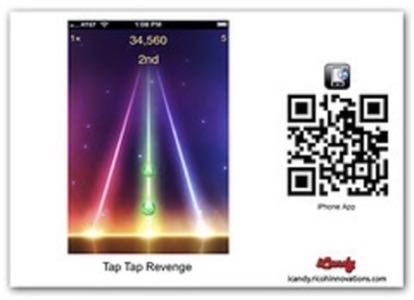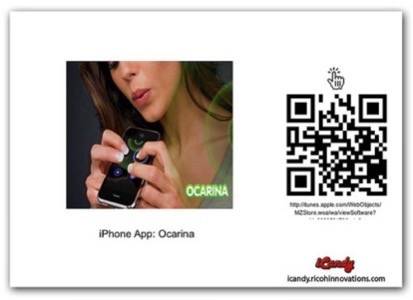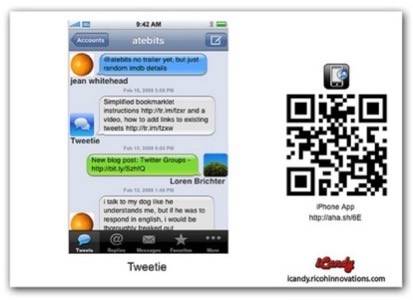The latest news from a company called iCandy (previous coverage) is a tool that lets you easily create QR codes for iPhone applications. By simply dragging an app out of iTunes and into their iCandy widget, a QR code for that application will be automatically generated. With this code, which could be printed on anything from business cards to posters and stickers, you can market your iPhone application offline, out in the real world.

Marketing iPhone Apps
If there’s any set of technology users who could kick the use of QR Codes into high gear it would be iPhone owners. Enamored of the some 25,000 applications now available in the iTunes App Store, iPhone users are happily downloading new apps all the time. The problem for developers isn’t coercing people into believing that it’s okay to install software on the phone – it’s generating awareness that the software they created even exists. In other words, raising app awareness is a marketing problem.
When an application becomes popular, it gets featured on one or more of iTunes’ “Top” lists which rank the hottest applications in their store overall and by category. But getting on these lists means first getting the message about your app out there. For some application developers, that means emailing every blogger and journalist who covers mobile technology hoping for a review. Others attend all the tech conferences they can, handing out numerous business cards.

But with iCandy’s widget, there’s now a third option for marketing an iPhone app in the offline world: QR codes. For those who don’t know, a QR code is a type of barcode which can be easily scanned using a mobile phone’s camera and accompanying third-party software. (iPhone users can check out apps like Optiscan, Neoreader, BeeTag, Xzing, 2D Sense, Barcode, Snapp, etc.)
How to Create a QR Code for an iPhone Application
For developers and marketers wishing to promote an application, they can do so using the iPhone App iCandy Card. The steps involved are simple:
- Launch iCandy and select “Create Card.”
- With iTunes open, find your iPhone app and drag and drop its icon into the iCandy Print window. iCandy will create a QR code of the URL that connects back to the iTunes store.
- Click ‘Edit Item’ to enter a relevant title and artwork.
- Select your print layout.
- Print to a local printer, disk, or Flickr.
Real-World Scenarios for Use
If creating and scanning barcodes with your mobile phone sounds too geeky for you, keep in mind this technology is inching its way closer to mainstream acceptance thanks to apps that scan the barcodes of products in order to do price comparisons. Consumers may even adopt the technology before the stores even know what’s happening! The reason, obviously, is that in a down economy such as this, anything that could potentially save people money is likely to be given more of a chance than before…even these slightly “geekier” applications that may have been ignored in the past. Add to that the ease-of-use of iPhone applications and it’s easy to see the still untapped potential of the QR code.

At iCandy, they suggest a couple of uses for their new app-to-QR-code widget, saying “imagine scanning a QR code on the ski lift tower that gets you a ski conditions app, or scanning a poster on the subway for a subway schedule app.” But we’re sure you can think of many more examples on your own. And with more businesses developing their own custom applications, we may not be too far off from a day when QR codes print on your receipts at your favorite store, show up on the menus at your favorite restaurants, or display in posters all over the city.
Well, perhaps we’re getting a little ahead of ourselves here. Although QR code technology has taken off in certain markets around the world, most notably Japan, they’ve only recently gained popularity in the Middle East, Europe, and the U.S. The problem in these markets may not be the unwillingness of consumers to adopt the technology, but the lack of QR codes out in the real world which are available for scanning. With iCandy, generating the codes is a breeze, but now someone has to convince marketers that they might be worth trying out.











